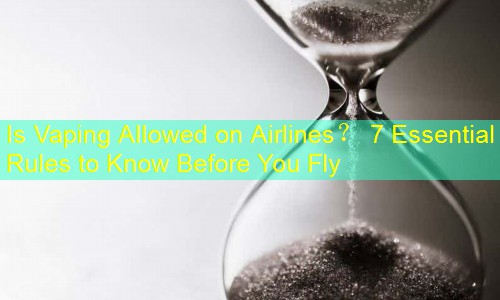Understanding the Regulations of Vaping on Airplanes

When traveling via air, it is essential to be aware of the rules that govern the use of electronic cigarettes, commonly known as vapes. Many passengers are curious about the legality and regulations surrounding vaping on airplanes. Here, we will delve into key aspects of taking a vape on a plane, including the quantity of vapes permitted, safety guidelines, and restrictions specific to airlines and airports.
1. Number of Vapes Allowed
Airlines generally impose restrictions on the quantity of vapes permitted in carry-on luggage. Typically, passengers are allowed to bring one personal vape device and several vape juice bottles, comparable to the restrictions imposed on liquid items. For safety purposes, it is advisable to adhere to the Transportation Security Administration (TSA) guideline, allowing liquids in containers of no more than 3.4 ounces (100 milliliters). Passengers should be mindful of their airline’s specific regulations, as some may impose stricter limits on the amount of vape liquid allowed.
2. Batteries and Charging Devices
Vape devices often contain lithium-ion batteries, which current regulations categorize as hazardous materials. As a general rule, spare batteries should not be placed in checked luggage but must be carried in carry-on bags. Most airlines allow one or two spare batteries per passenger, provided they are correctly protected from short circuits. Moreover, it is crucial to ensure that the vape device itself is turned off during the flight to prevent accidental activation.
3. Restrictions on Usage During Flight
While carrying a vape device on board may be permissible, the act of vaping during the flight is universally prohibited among commercial airlines. This includes all domestic and international flights. The smoking ban typically extends to electronic cigarettes, aligning with the extensive regulations surrounding traditional smoking to ensure the safety and comfort of all passengers. Passengers are urged to respect the no-smoking policies of airlines, as violations could lead to significant penalties.
4. Understanding Airline Differences
Different airlines may have varying policies regarding vaping products. Some airlines explicitly mention vaping devices in their regulations, while others categorize them under smoking products. For instance, prominent carriers such as Delta Air Lines and American Airlines maintain rigorous policies that prohibit vape use on board. Before traveling, passengers should thoroughly review their chosen airline’s policy on vaping to avoid any misunderstandings or inconveniences at the airport.
5. Consequences of Non-compliance
Disregarding airline regulations regarding vaping can lead to severe repercussions. Passengers caught vaping on an aircraft may face fines, be escorted off the plane, or even face legal action. Additionally, offenders may be banned from flying with that airline in the future. Safety personnel on board, including flight attendants, are trained to manage situations involving non-compliance, ensuring passenger safety remains a priority.
6. Airport Designated Areas
Certain airports may provide designated smoking areas that accommodate traditional smokers, yet the same does not apply to vaping. While some airports may possess areas where smoking is permitted, many do not allow vaping in these spaces. Passengers wishing to vape before their flight should consult the specific rules of the airport they are at, as policies can vary widely from one location to another.
7. Traveling Internationally with Vapes
When flying internationally, passengers need to consider the vaping regulations of their destination country. Some countries have strict laws relating to vaping, which could result in confiscation or legal consequences if not adhered to. It is advisable to conduct thorough research on the vaping policies of the intended travel destinations to avoid issues upon arrival.
Conclusion
Air travel necessitates strict adherence to safety regulations, especially concerning vaping devices. Passengers must be conscientious of both the quantity of vapes allowed and the regulations imposed by airlines and airports. Understanding battery regulations, restrictions on usage during flights, and the potential consequences for non-compliance is crucial for a smooth travel experience. By staying informed and prepared, travelers can ensure that their vaping habits do not disrupt their journey.














